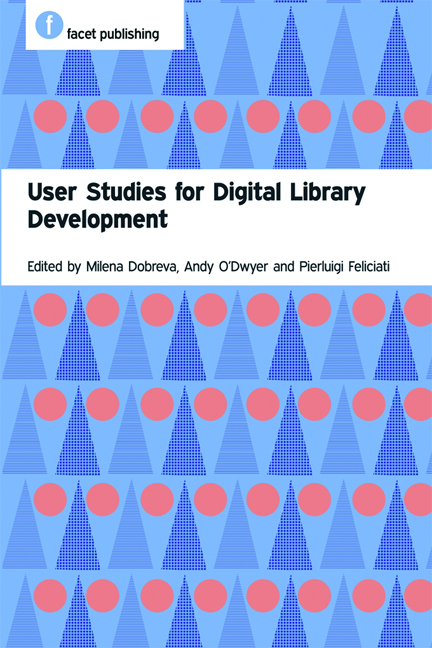Book contents
- Frontmatter
- Contents
- Preface
- Acknowledgements
- Abbreviations
- Glossary
- 1 Introduction: user studies for digital library development
- PART 1 SETTING THE SCENE
- PART 2 METHODS EXPLAINED AND ILLUSTRATED
- PART 3 USER STUDIES IN THE DIGITAL LIBRARY UNIVERSE: WHAT ELSE NEEDS TO BE CONSIDERED?
- PART 4 USER STUDIES ACROSS THE CULTURAL HERITAGE SECTOR
- 18 User studies in libraries
- 19 User studies in archives
- 20 User studies in museums: holding the museum in the palm of your hand
- 21 Digital art online: perspectives on user needs, access, documentation and retrieval
- 22 User studies for digital libraries’ development: audiovisual collections
- 23 A business-model perspective on end-users and open metadata
- PART 5 PUTTING IT ALL TOGETHER
- Index
20 - User studies in museums: holding the museum in the palm of your hand
from PART 4 - USER STUDIES ACROSS THE CULTURAL HERITAGE SECTOR
Published online by Cambridge University Press: 08 June 2018
- Frontmatter
- Contents
- Preface
- Acknowledgements
- Abbreviations
- Glossary
- 1 Introduction: user studies for digital library development
- PART 1 SETTING THE SCENE
- PART 2 METHODS EXPLAINED AND ILLUSTRATED
- PART 3 USER STUDIES IN THE DIGITAL LIBRARY UNIVERSE: WHAT ELSE NEEDS TO BE CONSIDERED?
- PART 4 USER STUDIES ACROSS THE CULTURAL HERITAGE SECTOR
- 18 User studies in libraries
- 19 User studies in archives
- 20 User studies in museums: holding the museum in the palm of your hand
- 21 Digital art online: perspectives on user needs, access, documentation and retrieval
- 22 User studies for digital libraries’ development: audiovisual collections
- 23 A business-model perspective on end-users and open metadata
- PART 5 PUTTING IT ALL TOGETHER
- Index
Summary
Introduction: the quintessence of the museum
When we visit a library or archive, we typically expect to find printed material: books, publications and documents. However, when we go to a museum – either in person or online – we expect a very different kind of experience. The physical museum invites us to discover exceptional and often extraordinary kinds of objects, and accordingly, when these very same objects are delivered online, they are managed very differently from the way books are managed by libraries, or the way that archives manage hierarchically arranged documents. As the footprint of the physical museum, an online museum is orchestrated to convey the singular and often spectacular nature of the objects, as well as the essence of the physical museum. This means that, as objects and works of art appear on the screen, the website needs not only to communicate the physicality of the objects but also to signify – in some way – the embodied space of the gallery.
As if we have just passed through the physical front door of the museum, the electronic portal signifies entrance to the online museum, and the collections are set up accordingly. Objects are not simply displayed as clutches of atomized objects, but are arranged in thematic order – as a collection or exhibition – according to a chronological logic, historical narrative or provenance, or according to artists or schools of art, in just the same way that they are presented in the physical museum.
The props and cues of the physical museum – catalogues, labels, wall texts and accompanying pamphlets – are presented online as descriptive labels and texts (metadata), serving both to identify the object and to maintain its place within the thematic series. Without these supporting descriptions an object simply gets lost, becomes an orphan, stripped of its role in the series and its place in the collection. These textual descriptions enable the user to discern what he/she is actually looking at. For example, just as colours in paintings need to be reproduced with fidelity in order to accurately convey the quality of artwork, so an archaeological object needs to be set in its historical and anthropological context so as to provide both intelligibility and meaning.
- Type
- Chapter
- Information
- User Studies for Digital Library Development , pp. 207 - 216Publisher: FacetPrint publication year: 2012



